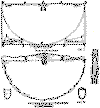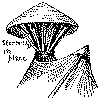by Ernest Thompson Seton

Making a Teepee
Many famous campers have said that the Indian teepee is the best known movable home. It is roomy, self-ventilating, cannot blow down, and is the only tent that admits of a fire inside.
Then why is not everywhere used? Because of the difficulty of the poles. If on the prairie, you must carry your poles. If in the woods, you must cut them at each camp.
A 10-foot teepee is the smallest size worth having for practical use. A larger one is easier to keep clear of smoke, but most boys will prefer the small one, as it is much handier, cheaper, and easier to make. I shall therefore give the working plan of a 10-foot teepee of the simplest form.
It requires 22 square yards of 6 or 8-ounce duck, heavy unbleached muslin, or Canton flannel (the wider the better, as that saves labor in making up), 100 feet of 3/16 inch clothesline, string for sewing rope ends, etc.
Get your material machine run together 20 feet long and 10 feet wide. Lay this down perfectly flat (Cut I). On a peg or nail at A in the middle of the long side put a 10-foot cord loosely, and then with a burnt stick in a loop at the other end draw the half-circle B C D.
Now mark out the two little triangles at A. A E is 6 inches, A F and E F each one foot; the other triangle, A R G, is the same size. Cut the canvas along these dotted lines.
From the scraps left over cut two pieces for smoke-flaps, as shown. In the long corner of each (H in No. 1, I in No. 2) a small three-cornered piece should be sewed, to make a pocket for the end of the smoke pole, or else a 2-inch hole right through.
Now sew the smoke-flaps to the cover so that M L of No. I is neatly fitted to P E, and N O of No. 2 to Q G.
Two inches from the edge B P make a double row of holes; each hole is 1 1/2 inches from its mate, and each pair is 5 inches from the next pair, except at the 2-foot space marked "door," where no holes are needed.
The holes on the other side, Q D, must exactly fit on these.
At A fasten very strongly a 4-foot rope by the middle. Fasten the end of a 10-foot cord to J and another to K; hem a rope all along in the bottom, B C D. Cut 12 pieces of rope each about 15 inches long, fasten one firmly to the canvas at B, another at the point D, and the rest at regular distances to the hem rope along the edge between, for peg loops. The teepee cover is now made.
For the door (some never use one) take a limber sapling 3/4 inch thick and 5 1/2 feet long, also one 22 inches long. Bend the long one into a horseshoe and fasten the short one across the ends (A in Cut II). On this stretch canvas, leaving a flap at the top in the middle of which two small holes are made (B, Cut II), so as to hang the door on a lacing-pin. Nine of these lacing-pins are needed. They are of smooth, round, straight, hard wood, a foot long and 1/4 inch thick. They skewer the overlapped edges together.
Storm Cap or Bull-boat
During long continued or heavy rains, a good deal of water may come in the smoke-vent or drip down the poles. To prevent this the Missouri Indians would sometimes use a circular bull-boat of rawhide on a frame of willows as a storm cap.
For a twelve-foot teepee the storm cap should be about four feet across and eighteen inches deep, made of canvas with a hem edge in which is a limber rod to keep it in circular shape. It is usually put on with a loose teepee pole, and sits on top of the poles as shown, held down if need be by cords to its edge.
The poles should be short and even for this.
Putting Up the Teepee
Twelve poles also are needed. They should be as straight and smooth as possible; crooked, rough poles are signs of a bad housekeeper--a squaw is known by her teepee poles. They should be 13 or 14 feet long and about 1 inch thick at the top. Two are for the smoke-vent; they may be more slender than the others, and should have a 4-inch crosspiece lashed on them about 2 feet from the top. Last of all, make a dozen stout short pegs about 15 inches long and about 1 1/2 inches thick. Now all the necessary parts of the teepee are made.
This is how the Indian tent is put up: Tie three (some use four and find it stronger) poles together at a point about 1 foot higher than the canvas, spread them out in a tripod the right distance apart; then lay the other poles (except three including the two slender ones) in the angles, their lower ends forming a small circle. Bind them all with a rope, letting its end hang down inside for an anchor.
Now fasten the two ropes at A (Cut I) to the stout pole left over at a point 10 feet up.. Raise this into its place, and the teepee cover with it, opposite where the door is to be. Carry the two wings of the tent around till they overlap and fasten together with the lacing-pins. Put the end of a vent-pole in each of the vent flap pockets or else through the holes there, outside of the teepee. Peg down the edges of the canvas at each loop. Stretch the cover by spreading the poles. Hang the door on a convenient lacing-pin. Drive a stout stake inside the teepee, tie the anchor rope to this and the teepee is ready for weather. In the center dig a hole 18 inches wide and 6 inches deep for the fire.
The fire is the great advantage of the teepee, experience will show how to manage the smoke. Keep the smoke-vet swung down wind, or at least quartering down. Sometimes you must leave the door a little open or raise the bottom of the teepee cover a little on the windward side. If this makes too much draught on your back, stretch a piece of canvas between two or three of the poles inside the teepee, in front of the opening made and reaching to the ground. The draught will go up behind this.
By these tricks you can make the vent draw the smoke. But after all the main thing is to use only the best and driest of wood. This makes a clear fire. There will always be more or less smoke 7 or 8 feet up, but it worries no one there and keeps the mosquitoes away.

